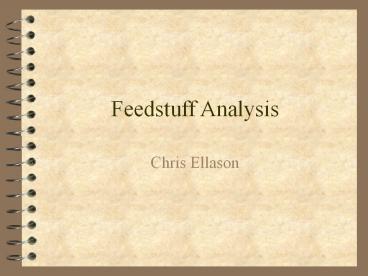Feedstuff Analysis - PowerPoint PPT Presentation
Title:
Feedstuff Analysis
Description:
... a result of poor grain/fiber balance Excessive grain consumption results in excessive lactic acid production Ruminants Enterotoxemia ... – PowerPoint PPT presentation
Number of Views:168
Avg rating:3.0/5.0
Title: Feedstuff Analysis
1
Feedstuff Analysis
- Chris Ellason
2
Feedstuff Analysis
- Feed Sampling
- Proximate Analysis
- Dry matter
- Ash
- Crude Protein
- Ether Extract
- Crude Fiber
- NFE
3
Detergent Method
- NDF - cell wall components
- cellulose
- hemicellulose
- lignin
- silica
- heat damaged protein
4
Detergent Method
- ADF - Acid Detergent Fiber
- lignocellulose
- NDF used to predict gut fill and intake
- ADF used to predict digestibility
- ADIN - acid detergent insoluble nitrogen
5
Know the Form of the Numbers
- Dry Matter Basis
- As-fed Basis
- Air-dry Basis
6
Energy Measurements
- Gross Energy - GE
- total potential energy of a feedstuff
- determined by bomb calorimeter
- Fecal Energy - FE
- Energy from undigested feed and other components
of feces - Determined by bomb calorimeter
7
Energy Measurements
- Digestible Energy - DE
- GE - FE
- Gaseous Products of Digestion - GPD
- combustible gasses that escape during digestion
- mainly methane, traces of H, CO, H2S
- Urinary Energy - UE
- loss of spent metabolites and energy through urine
8
Energy Measures
- Metabolizable Energy - ME
- referred to as usable portion of ingested energy
- DE - UE - GPD ME
- Heat Increment - HI
- heat derived from metabolism or fermentation of
feedstuffs
9
Detergent Method
- Energy
- NEm
- NEg
- NEl
- These values are calculated from ADF and NDF
10
Net Energy - NE
- Net Energy computed by ME - HI
- Includes the amount of energy used for
maintenance plus some production component - NEM
- amount of energy expended to maintain energy
equilibrium
11
Net Energy
- NEM
- basal metabolism
- energy of voluntary activity
- warming of body
- cooling of body
- Net Energy for some production function
12
Energy Measurements
13
Common Feeds
- Carbonaceous Concentrates
- High in Energy
- Low in fiber
- Low in Protein
- Variable in protein quality
- fair in P
- low in Ca
14
Concentrates
- Corn
- high energy
- 8 - 9 CP
- Low in Lysine
- Sorghum Grain
- Must be processed
- lower in energy than corn
- higher in CP than corn
15
Concentrates
- Oats
- 75 - 85 energy of corn
- very palatable
- higher in fiber than corn
- Beet Pulp
- Molasses
16
Concentrates
- Citrus Pulp
- Animal Fat
- Cookie Meal
17
Protein Feeds
- Soybean meal
- low in Ca
- most complete in energy and protein
- Cottonseed meal
- Peanut Meal
18
High Moisture Feedstuffs
- Green Chop - forage chopped in the field and fed
without further processing - Silage - forage cut wet and put through
controlled fermentation
19
Vitamins and Minerals
- Add Vitamins to assure adequate amounts
- Mineral supplementation
- all minerals are not created equal
- greater absorption of sulfates over oxides
- example CuS vs CuO
20
Feed Additives
- Antibiotics
- Chlortetracycline
- AS700
- Growth Stimulants
- ionophores - Bovatec, Rumensin
- Others
- MGA - used to stop heat
21
Problems Associated with Grain Feeding
22
Non Ruminants
- Enteritis
- Characterized by inflammation of stomach and
possibly SI - Antibiotics in starter rations can control this
to some degree - Dietary changes, erratic feed intake and weaning
stress - Also grain overload or highly fermentable feeds
23
Non Ruminants
- Laminitis (founder)
- Inflammation of the laminae
- Typically a result of poor grain/fiber balance
- Excessive grain consumption results in excessive
lactic acid production
24
Ruminants
- Enterotoxemia over eating disease
- Increase in clostridial organisms
- Severe kidney damage and pin-point hemorrhages in
intestine - Clostridial vaccination
25
Ruminants
- Lactic acidosis grain overload
- Overgrowth of bacteria which prefer lower pH
environment - These are the starch digesting bacteria
- As they increase pH drops further
- Primarily due to their production of lactic acid
26
Ruminants
- If unchecked acids can be absorbed into the
bloodstream resulting in metabolic acidosis - Endotoxins and histamine can result in founder
- Liver abcesses
- Acidosis can occur in either acute or chronic form
27
Polioencephalomalacia (PEM)
- Primarily caused by over eating grain
- Organism in grain causes ruminal production of
Thiaminase - Causes an acute thiamin deficiency
- Other PEMs can occur by intakes of high sulfate
water or feed - This type is not responsive to thiamin treatment
28
What to watch for
- Dairies low butterfat
- Humping of back
- Kicking at stomach
- Altered intake
- Fever
29
What to watch for
- Gut sounds and motility
- Rumen pH
- Cud chewing
- Feed sorting
- Hoof problems (softening, white line, sole
abcesses) - General unhealthy appearance (eyes, ears etc.)































